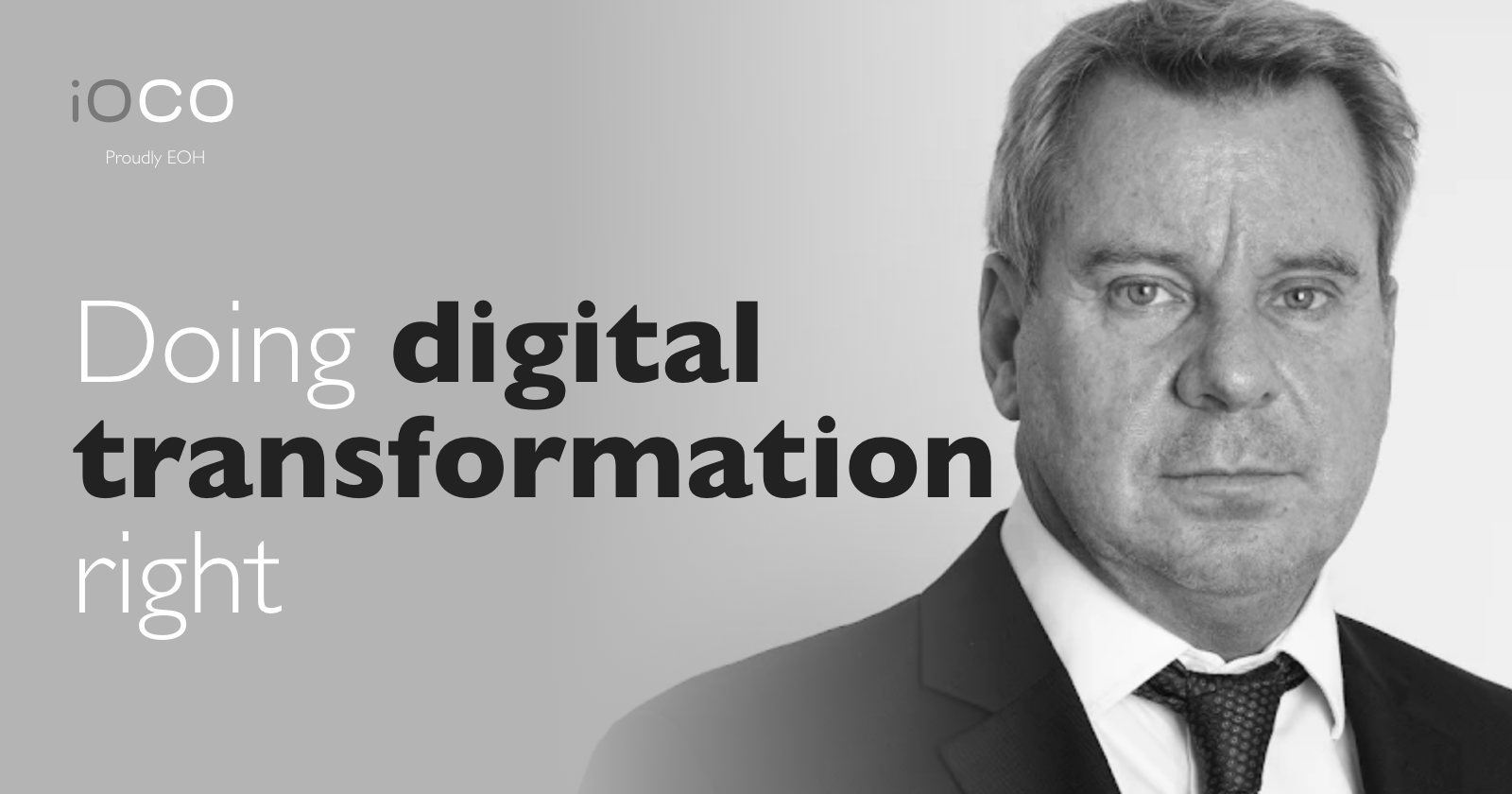By Brian Harding, Head of iOCO Digital
Digital transformation has been a business buzzword for many years now, but while most organisations have already embarked on the journey, they often forget that digital transformation always needs to be viewed in the context of the end consumer. Typically, organisations embark on a digital transformation journey to drive growth and sustainability, improve productivity, and deliver a more engaging customer (and employee) experience. However, many digital transformation initiatives fail to reach these goals.
This is often due to companies taking a fragmented approach and implementing specific digital technologies to solve individual business problems, rather than reimagining the business as a whole, based on what customers need. Developing a clear digital strategy supported by the leadership and culture to foster change and drive transformation is also often overlooked.
In fact, as many as 70% of digital transformation efforts fail because technology is the focus of transformation efforts. Technology is simply an enabler, and should not be seen as the main component of digital transformation. People, not technology, are the most important determinant of success in digital transformation.
The World Economic Forum and Bain & Company have developed a framework based on four pillars that support successful digital transformation. A company contemplating digital transformation should start by determining where their industry is heading and where the business should be going (despite the current climate of uncertainty), developing a transformation strategy, and aligning its people around it. Next, it should reimagine its business model based on customer needs. The third step is for the business to examine how the enablers that drive transformation—current data, technology, operating models and talent—enable or hamper digital progress and finally, it should consider orchestration, or how to manage the transformational change.
Shifting skills
The faster the car goes, the easier it is for the wheels to fall off. To deal with speed, you need very disciplined processes. As we move into a phase of dramatic transformation across the board, organisations need the ability to drive with clear objectives, measurability and feedback.
A recent IBM CEO Study revealed that key themes this year should be flatter, faster and more flexible leadership structures, a shift to remote and hybrid work, the increasing importance of emerging technologies, open innovation and cyber security. When comparing South African CEOs with their international peers, the local participants show a stronger than average focus on data and the technology enabling them to derive insights from it.
Successful digital transformation requires organisation-wide commitment and significant investment in digital capabilities and technology. A 2020 study by Boston Consulting Group (BCG) reveals that a staggering 70% of transformation efforts fail to reach their goals. There are many factors that businesses need to get right to improve their chances of success. These can range from strategy and technology to infrastructure; however, according to BCG, the people dimension (organisational design, operating model, processes, and culture) is often the most critical determinant of success.
Many business leaders point to a lack of skills as one of the key impediments to transformation. Unsurprisingly, given the scope, speed, and scale of technological transformation, Gartner reports that many organisations struggle even to identify what skills they need to execute digital initiatives, let alone build these capabilities. As a result, many companies simply do not have the right mix of skills and expertise to drive new thinking, keep abreast of technology changes and execute a successful transformation. What’s more, digital skills are in high demand and are difficult to find, and it can be costly and time-consuming to source, develop and retain the right talent and create a digitally-driven culture.
Strategic decisions
A few years ago, digital transformation was all about apps with the intent of creating a new user experience. Often you had the same organisation, structure and processes, and a new front-end in the form of an app. That doesn’t really transform the client experience. Approaching digital transformation from a client experience view is crucial for client facing organisations and this should go deeper than the front-end experience.
Historically, IT systems, processes and security have been managed in the same way for many years with customer data being housed only on a few systems, meaning that IT tools were static and security meant anti-virus, firewalls and passwords. But digital transformation has changed many aspects of IT with layers of IT growing exponentially. As new applications are introduced, customer data is now found in many new places and infrastructure is increasingly distributed across public and private clouds and internally managed data centres. From a security perspective, this puts companies in a more difficult position when it comes to compliance with data privacy regulations such as PoPIA and other industry regulations.
There is still a high degree of uncertainty around how current technology will develop and the impact it will have on business—it’s evolving rapidly, outpacing the rate at which many organisations can adapt. This uncertainty, coupled with a lack of specialist skills to support new ways of working, has led CIOs to consider operating in a world where technology is shared, utilising what they need, as and when they need it. Rather than forecasting technology and investing large amounts of capital to own infrastructure, pay-per-use utility-based computing, enabled through a hybrid cloud platform, is fast becoming a requirement for many businesses.
Unfortunately, most companies struggle to find the right combination of public, private, and hybrid environments. There are numerous options available (all with pros and cons); however, with an abundance of choice comes a lot of complexity. There is no optimal mix of platforms and services for everyone. Ultimately, a company’s strategic business objectives, coupled with factors such as technology, security, governance, compliance, and professional services, will determine which hybrid model is used.
The flexibility of hybrid cloud
The remote working explosion has introduced different work-from-home requirements with concomitant changes in consumer behaviour. Predominantly online purchasing patterns have brought a huge shift in the way companies manage their systems and processes and a corresponding change in how we need to secure them. The proliferation of the Internet of Things (IOT), being driven by 5G advances, is a key driver of the pace of adaptation necessary in a hyper-connected world, with every appliance, machine, camera or car streaming real-time data which will be used by companies to provide an even higher level of intimacy and personalisation.
Hybrid cloud has therefore become the magic layer that enables organisations to put each of their applications in its ideal environment while creating a seamless experience between public and private infrastructure and addressing key factors like technology, security, governance and the like. The cloud experience has simplified IT and given developers and IT operations the ability to scale new apps and capabilities, significantly shifting the way applications are being developed. Today’s microservices architecture enables developers to rapidly design, build and deliver lightweight, scalable cloud-native applications using various toolsets on Azure, AWS, Google Cloud Platform and other public cloud platforms, as well as private cloud environments.
Building apps this way provides agility and enables solutions to reach the market with unprecedented speed while reducing development and infrastructure costs. It is especially useful if an app is required for a specific period or project—it can be used for the duration of the project and then closed down. It is pay-per-use, so businesses don’t need to invest in software, licences and extensive infrastructure in the private hosted data centre. Previously, app development using very structured traditional toolsets was a lengthy and costly process that could take months to deploy.
Priorities
Digital transformation is a key priority for every major organisation, but amid budget cuts and market uncertainty, achieving transformation is easier said than done. Decision-makers are under growing pressure to make the right investments to support future needs.
Organisations see all these new options – like hyperscale, better security and automation – and they are asking, how do I take what I have and pull together these new toys to link back to my strategy? This is the role of technology consulting firms like iOCO, which can help them develop roadmaps, assess TCO, and justify the value of the spend to the board, so they can make decisions better and faster.
A recent study out of Harvard Business School ranked the following qualities as most critical to succeeding in the digital era: Data informed decision-making was cited by 61%, followed by customer focus at 55%, cross-functional collaboration with 51%, and continuous learning at 44%. It’s notable that there’s a significant segment of the leaders surveyed — about half — who do not yet see these initiatives as priorities.
However, while all of these are important, companies are still struggling to get some of them to work. Everyone across an organisation should have access to data analytics, for example. This will not only enable a more customer-centric focus, but enhance collaboration as well. The primary qualities of digitally transformed enterprise should therefore include: Increasing customer satisfaction; data-based insights that turn into actionable, revenue-generating actions; and enabling future digital growth.
As organisations start working towards achieving their goals for 2023, they should bear all of these factors in mind. Doing digital transformation right will be the key to success this year.



